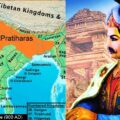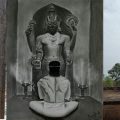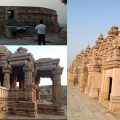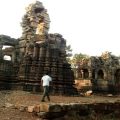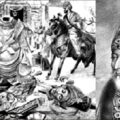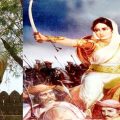Temples, Stepwells Built by Gurjara Pratiharas in Alwar and Dausa (Cir.725 – 1027 AD)
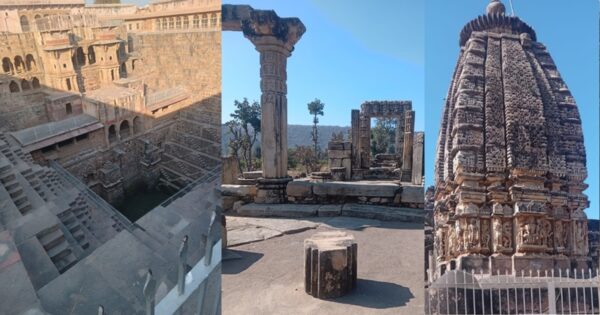 The Gurjara Pratihara Dynasty (725-1027 A.D.) is one of the longest lived dynasties in the history of India. Gurjara Pratiharas the spearhead of a religio-cultural upsurge were great rulers, warriors and builders. The broad circuit formed by Alwar and Dausa distts. is dotted with some rich archaeological and architectural sites of beautiful temples and stepwells which were built by the rulers of this dynasty, particularly in Abhaneri and Rajorgarh. The key land mark of the circuit is wide expanse of the Arvalli hills. A distinguished feature of the Aravallis in this area is the formation of sheltered valleys with regular streams of water secured by lofty hills, abundant mineral resources, vast fields abetting the growth of settlements. Gurjars are the predominant settled group. Besides Gurjar ethnicity, Brahmans, Malis, Jogis, and Meenas are important components of population.
The Gurjara Pratihara Dynasty (725-1027 A.D.) is one of the longest lived dynasties in the history of India. Gurjara Pratiharas the spearhead of a religio-cultural upsurge were great rulers, warriors and builders. The broad circuit formed by Alwar and Dausa distts. is dotted with some rich archaeological and architectural sites of beautiful temples and stepwells which were built by the rulers of this dynasty, particularly in Abhaneri and Rajorgarh. The key land mark of the circuit is wide expanse of the Arvalli hills. A distinguished feature of the Aravallis in this area is the formation of sheltered valleys with regular streams of water secured by lofty hills, abundant mineral resources, vast fields abetting the growth of settlements. Gurjars are the predominant settled group. Besides Gurjar ethnicity, Brahmans, Malis, Jogis, and Meenas are important components of population.
Based in Kannauj the Gurjara Pratiharas held an imperial sway greater than the Guptas and Harsha. Unlike the limits of Harsha’s empire which has been defined to us by vague expressions in the literary work of the time, the bounds of Gurjara Pratihara empire are determined by unquestioned archaeological evidence of inscriptions coins and monuments.
The Gurjara Pratihara Empire was founded by Nagabhatta in the first half of eighth century and was established through the efforts of Bhoja (Cir.836-885 A.D.) and Mahendrapala (885-910 A.D.). The Empire at one time expanded in the from Bay of Bengal in the East to Arabian sea in the West, from Himachal Pradesh in the North to Vindhyas in the South. It continued in its full glory for about two centuries under Mihir Bhoja, Mahendrapala and their successors. The credit of Pratihara rulers lay in their successful resistance of the invasions of the Arab/Turks from the west and attack of Rashtrakutas from the south.
Gurjara Pratiharas were of the people and did not stand away from their hopes, aspiration and traditions. The spreadhead of cultural revival, rulers of this dynasty were “bulwarks of defense” against the “vanguard of Islam” and “protectors of Dharma”. Yet despite such confident statements, despite frequent references by Islamic writers and historians and despite a succession of well attested rulers, the origin of the Gurjara Pratiharas remains an enigma.
Were the Gurjaras an indigenous desert tribe who were abruptly inspired to take martial exploits in more favoured lands or were they to be seen in the context of tribal entities like Youdhayas or Arjunayas or whether still they had migrated from outside India? The association of Gurjara Pratiharas with the Hunas as supposed by Hoemle and others rests on very flimsy grounds. It must not be forgotten that Hunas could not be assimilated into Hindu society till 11th century but for the Gurjaras it is strange that dust raised by their inroads took no time to settle down. Such a thing would have been an impossibility if they had been foreigners.
The identification of the Gurjara Pratiharas with Khazars was first suggested by A.M.T. Jackson and subsequently endorsed by Bhandarkar is based on slender evidence of similar ending. Other arguments in support of foreign origin theory are their sudden emergence as a political power in the 6th century, their gradual spread from Punjab to S.E. and a reference to the division of Gurjaras on the banks of Ganga and Yamuna called Kushane. These arguments are not very strong as Dr. R.C. Majumdar points out. The advance of Gurjaras from Punjab is neither certain nor can it by itself suggest their foreign origin.
Taking into consideration the entire evidence epigraphic, literary, foreign and linguistic, Dr. B.N. Puri, a distinguished historian, in his book History of the Gurjara Pratiharas suggests the Indian origin of the Gurjara Pratiharas. Their extensive conquests were often made and subsequently controlled by feudatories who were often relations. When the empire disintegrated, it transformed into powerful kingdoms that often claimed the similar Kshatriya status and similar Gurjara provenance e.g. Tanwars of Inderpat/Delhi, Chauhans of Shakambhari, Parmars of Dhar and Chalukyas of Gujarat.
It is really unfortunate that Kannauj, the capital city of the Gurjara Pratiharas has no extant monuments to illumine our way for the study of art and architecture by rulers of this dynasty. The main reason for this is evidently the vast scale of plundering, effected at the hands of the Muslim invaders right from the early 11th century when Sultan Mahmud repeatedly attacked Kannauj and destroyed a large number of temples.
Each year, millions of tourists throng Delhi, Agra and Jaipur, palaces, forts, mosques and tombs. A vast number of studies and guidebooks are devoted to them. Only a few kms. off the busy highway between Jaipur and Agra, one may see the most astounding Gurjara Pratihara monuments of Harshat Mata temple and Chand Bawri at Abhaneri, the beautiful 10th century Neelkanth Mahadev temple and an ancient step well at Rajorgarh. Ask India lovers if they have visited these amazing historical sites and they will nearly always say “No”.
Certainly these monuments are off the well worn tourist track but by venturing away from their strict itineraries just a little, visitors may be rewarded with an authentic welcome from helpful albeit slightly mystified locals. According to the proud residents of Abhaneri, the village so called because the Goddess Harshat Mata in the local temple was shown in a joyful mood and spread brightness or Abha all round. It was Abhanagri before and is now popularly called Abhaneri. Another view is Abhaneri is better known to the historical world as Abhaynagri, literally a fearless city of the Gurjara Samrat Mihir Bhoja.
According to the residents, the village was founded by Raja Chand. It is this Raja Chand / Mihir Bhoja of the legends referred to by Tod in his Annals and Antiquities of Rajasthan. Scholars like Budh Prakash and K.M. Munshi have made similar statements basing their inferences on the Daulatpur and Gwalior inscription of Adi Varaha Mihir Bhoja. Art critics have followed suit by quoting them extensively. These literary, legendary and inscriptional evidence enable us to say with confidence that the maker of Chand Bawri and founder of Harshat Mata temple at Abhaneri was the 9th century emperor with imagination having close connect with the region. All evidences point to the Gurjara Pratihara Samrat Mihri Bhoja. After the desecration of the Harshat Mata temple by Muslim invaders, the township was deserted. A couple of centuries back the first to return were the descendants of the priests of the temple. After them came the Gurjara Pratiharas, two larges groups as per official records.
Chand Bawri is the most impressive of all the step wells of ancient India even though most people do not realize they have seen it. It has featured in the much loved Hindi movie Paheli and few popular Hollywood blockbusters. It is the most amazing step well of India by virtue of its immense size depth and dazzling steps. It is a complex structure revamped through centuries by various rulers the first and the most important was Mihir Bhoja. It is certainly fortunate that most of the edifice was left intact and untouched close to the water’s edges by the Muslim invaders. The rhythm of its 3500 steps is hypnotic. The scale of Chand Bawri is overwhelming and thousands of its steps mesmerize the visitors with its aura. Its shaded balconies and tiers of pyramidal steps on three sides is a reminder of Katan Baoli of Osian of roughly the same period. Osian was a prominent trading center and an important and fascinating pilgrimage site for the Jains and Hindus. Chand Bawri has exceptionally beautiful carvings on columns and ornamental niches of Deities. At the twelfth level down the remains of the Bawri are remarkably well preserved shrines retaining their deities overlooking the sacred water.
The Bawri close to Harshat Mata temple performed more functions than any other public building of its time. One most important function was as a place of devotion where ritual purification and prayers were performed. Hinduism equates the giving properties of water with fertility and mother-goddess. Water holds the special place in every Hindu’s life. In Hinduism digging a water harvesting system like the temple kund or stepwell is considered a great meritorious deed. Chand Bawri is a testimony to the traditional water harvesting system developed in ancient times and to the engineering and construction skills of those who built it,. These stepwells built near the temples are unique to India as they were built as a response to India’s dramatic but predictable climate which specially in the arid Aravalli region guarantee a bone dry environment for most of the year followed by weeks of rain. It was imperative to establish a reliable year round water supply and this required access to water table. Stepwells were designed as cisterns that could retain the precious resource for a long time, a flight of steps ensured that water could be accessed even when it retreated to the lowest level. Chand Bawri was a civic centre that contributed to the quality of life of the people around it. Till very recent times villagers bathed in Chand Bawri and it was the venue of village meetings. The Bawri is now cordoned off by railings to avoid any mishap.
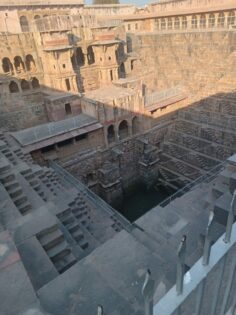
Opposite to Chand Bawri stands the Harshat Mata temple. The original temple appears to have been built in Panchayatana style. Only parts of the main shrine survive now. No epigraphic evidence survives regarding the temple’s construction. However, its architectural and sculptural remain leads to the conclusion that Gurjara Pratihara Samrat Mihir Bhoja built it. The sculptures on the temple walls have largely been lost though a few survive. Much of the platform survives but most of the sculptures have been removed to the various museums in Rajasthan. The temple remains in religious use.
Despite the rhetoric about our pride in our ancient civilization and culture we are remarkably casual about protecting our sculptural heritage. It was shocking to learn from the temple priest that in 1968 the original image of Harshat Mata was stolen from the temple. Neglect alone does not explain the loss of this national treasure. Organized smuggling network must have played its part in the artefact getting stolen that was under the protection of ASI.
Hopefully the renewed impetus that has been given to the protection of India’s cultural heritage may yield fruitful results in the case of Abhaneri too as another valuable statue of Shiva belonging to the Gurjara Protihara period and stolen from Ghateshwar temple in Badoli Chittorgarh has been finally brought to India from England in July 2020.
Just about an hour’s drive from Abhaneri, Rajorgarh is situated on a lofty hill. After the famous temple of Nilkanth Mahadev, this place is popularly called Nilkantha. Rajorgarh was first mentioned by Tod in Annals and Antiquities of Rajasthan. This site was later visited by Alexander Cunnigham. Presently, the A.S.I. has taken over the site of Nilkantha under its control and is carrying out work of excavation and preservation of the site.
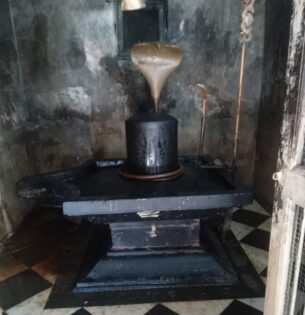
The site holds a prominent place in the reconstruction of Gurajara Pratihara history due to its artistic splendor and inscriptions which were found here. Early medieval site of Nilkantha has scattered ruins of hundreds of temples and stepwells. The single standing temple of Nilkantha Mahadev amidst the ruins is the only one that survived the attack of Aurangzeb. The temple has been partly reconstructed by the ASI and many devotees come here to offer their prayers. We were fortunate to meet the temple priest and an attendant of ASI at the site who guided us to different ruined Hindus and Jain temples and stepwells scattered over a large area. The site is surrounded by fields but not much habitation can be seen nearby.
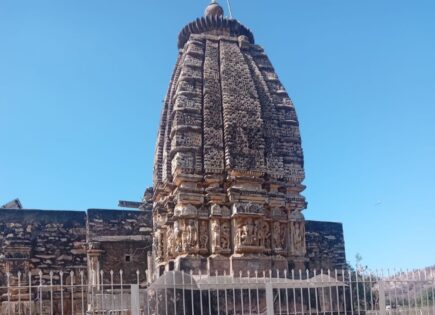
Neelkantha temple
Inscriptions found from Rajorgarh are important source for the reconstruction of the history of the Gurjara Pratihara dynasty. An inscription of V.S. 1016 or 959 A.D. was found in about 1876 near the temple of Nilkantha among the ruins. This inscription is placed in the Govt. Museum Alwar now. The Rajorgarh inscription of Maharajadhiraj Paramesvara, the illustrious Mathan Deva of the Gurjara Pritahara line, son of Maharaj Savata and Lachuka, records the grant of village Vygrahapataka on the occasion of the consecration of the temple of God Lachukesvara (Siva) named after his mother Lachuka.
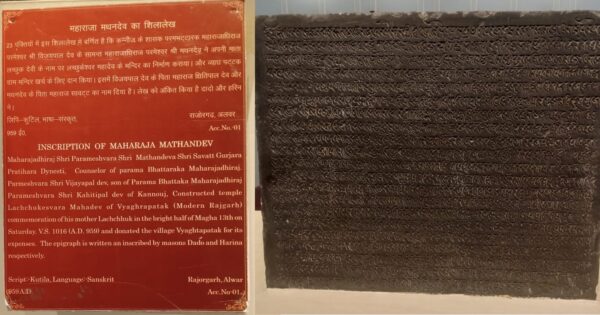 Another inscription dated V.S. 1239 A.D. 1189 and at display in the medieval gallery of National Museum throws light on how a queen named Kailachchadevi was dissuaded from committing sati.
Another inscription dated V.S. 1239 A.D. 1189 and at display in the medieval gallery of National Museum throws light on how a queen named Kailachchadevi was dissuaded from committing sati.
The Naugaza Digambar Jain temple is situated near Neelkanth temple Rajorgarh. According to an inscription in the National Museum, the temple was constructed in V.S.979, 922A.D. during the reign of Gurjara Pratihara ruler Mahipala of Kannauj. This inscription mention Sarvadeva of Simhapadra as the architect of the temple. Only a colossal 5.33 mts. (17.5. feet) statue of Jaina Tirathankar Shanti Nath
remains intact.
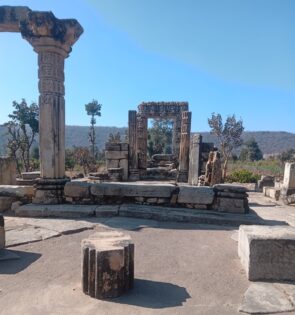
Some labored attempts have been made to dissociate Pratiharas from the Gurjaras in the inscriptions. One must remember in early India Janapada names were commonly interchangeable with tribal names. Documents dating from 7th century clearly show a wide distribution of Gurjaras as a political power in India. In the Rajorgarh inscription there is also mentioning of fields cultivated by the Gurjaras.
Amongst the many sculptures at the sites and at Alwar Museum perhaps the most impressive is the Varaha Sculpture. The body of God Vishnu who became a mighty boar to rescue the earth from the ocean convey the impression of a great primeval power working for the good against the forces of chaos and destruction and bears the message of hope strength and assurance. An interesting aspect of the sculpture is the depiction of woman warrior on top left. From the testimony of Rajshekhar and Suleman and from the sculpture depiction we know that no veil concealed women in the eyes of the visitors. Describing the deeds of the greatest emperor of Northern India Mihir Bhoja the poet Baladitya refers to him as Srimad Adi Varaha and suggests that he “like Kumara with his hosts of matrikas performed wonderful deeds, subdued the terrible Asuras with the help of women that lived upon arms.”
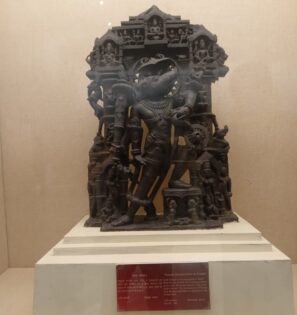
The chivalrous traits did not blemish feminine grace and charms of the ladies of that period. Surasundari sculptures in the pillar of the temples give us idea of the refinement and ornamental tastes of the ladies. From the literary and archaeological finds we know that during Gurjara Pratiharas heydays, knowledge of music was looked upon as an essential attribute of a refined person. The man who knows nothing of music, literature or art runs an ancient proverb is nothing but a beast without the beasts’ tails and horns. Close to the Neelkanth temple, there is a beautiful stepwell in use for religious and purification purposes. Water works for the use of public or large sections came to be regarded as more meritorious than sacrifices in the gifts of which only Brahamanas benefitted. The offering of water whether to travelers passers by or animals was a teaching observed by followers of many faiths specially Hindus and Jains who were patrons of these step wells and temples. It was heartening to see that this practice still continues in our villages which are untouched by the trappings of modernization and commercialization. In the courtyard facing the Neelkanth temple a lady sitting with shelfs of waterpots offered water lovingly to the devotees and visitors. A benevolent act on a smaller but meaningful scale.
Walking the paved pathway along beautiful mustard fields guarded by little boys sitting on a stand fixed up on four poles in the middle of a field with a sling and clay balls to drive away the ravens, peacocks and other birds who destroy their crops we reached the ruined Jaina temple. Gigantic statue of Bhagwan Shantinath measuring 5.33 mts (17.5) filled us with amazement. The magnificent sacred image object of veneration for countless generations of devotees is now lying in neglect. It will take time for govt. in power to nurture respect and pride for historically significant monuments that have lost their glory due to ravages of nature and vandalism and destruction by icono clastic invaders. The least that ASI can do is to put plaque in honour of these builders of “Poetry in stone”. Inscriptions at Alwar Museum and National Museum Delhi clearly name the patrons of these beautiful Hindu and Jain temples the Gurjara Pratihara rulers Mahipala and Vijaypala and his feudatory Mathandeva.
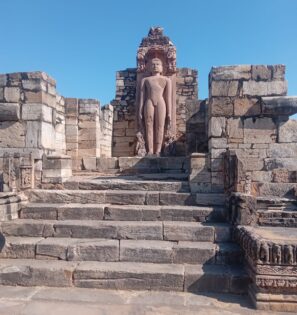
There are very few studies which exist on the art and architectural heritage of the Gurjara Pratiharas and sadder still since they are located away from the centers of powers few care to visit them. Let us look forward to the times when tourists start pulling up their vehicles in remote villages and towns which ware centres of India’s architectural cultural and social history.
Addressing a group of young men in Alwar, Rajasthan some time in 1891, Vivekanada asked them to prepare themselves to eventually write history “Work and discipline to write accurate, sympathetic and soul inspiring histories of the land. It is for Indians to writer Indian history. Therefore set yourself to the task of rescuing our lost and hidden treasures from oblivion”.
References:
1. Ancient India – R.C. Majumdar
2. Annals and Antiquities of Rajasthan – James Tod
3. India – John Keay
4. The History of the Gurjara Pratiharas – B.N. Puri
5. History of Ancient India Vol.5- Dilip K. Chakarbarti Makhan Lal
Editors.
6. The Making of Early Medieval India – B.D. Chattopadhaya.
7. The Vanishing Stepwells of India – Victoria Leutman
8. Art and Icon – Devangana Desai.
9. The Dynastic History of India – H.C. Ray.

